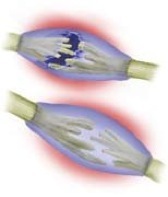Nerves carry signals from the brain to the body and vice versa. The brain sends directions to the muscles to move, while the skin and other sensory-innervated organs send information about the surroundings (pain, temperature, pressure) to the brain.
 When a nerve is injured, the signals it carries do not get to their destinations. You might lose motor function of the muscles controlled by the nerve or sensation in the areas supplied by the nerve, or both.
When a nerve is injured, the signals it carries do not get to their destinations. You might lose motor function of the muscles controlled by the nerve or sensation in the areas supplied by the nerve, or both.
Injury of the nerve also results in the nerve part farthest from the brain dying. If the nerve’s “insulation,” or myelin, is still there, the nerve might try to heal. If the nerve and the myelin are cut, you might get a painful neuroma, or nerve tumor, at the area of the cut.
Nerves sometimes can be repaired by stitching the myelin together. If there is nerve “missing,” a graft or a nerve “conduit” might be used to bridge the gap. It takes about a month for the nerve to “wake up” and then nerve “growth” occurs at a rate of about 1 mm each day; that means that a nerve injury around the elbow might take a year to return sensation to the fingertips! Tingling in the fingertips during the period after surgery can be a good sign of recovery. Nerve repairs are much more successful in young patients, especially children and teenagers.
You might be sent to therapy to keep your joints from becoming stiff while your muscles are not working. You will need to be careful not to injure the areas of your body that you can’t feel; you could cut or burn your finger without even knowing it.
Unfortunately, some nerve injuries can cause permanent loss of function or sensation.